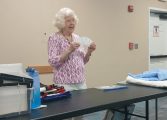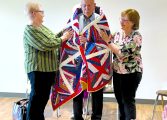“I was the oldest in the class; they used to call me Pops,” he said, laughing. “When you’re in your teens and 20s you’re not focused. Later I became more focused and worked hard. When I was at VCU, I had to do six paintings and one had to be six feet in one direction.”
While sitting in gridlocked traffic, Tartaglino realized he could extract a composition from a traffic jam. It became his six-foot painting called 7:38. It eventually hung in an airport until a doctor purchased it.
Tartaglino then described his routine as an artist. Passionate about recycling, like most artists, he is always repurposing items so as to save on the cost of newer, more expensive equipment. When he pulled out a canvas, his onlookers had no idea it was not a traditional canvas but rather a Luan door covered with gesso and stretched canvas.
“This makes a sturdy support and is less likely to warp,” he said. Often he goes to the Habitat store and get doors for as little as $5, he said. He also adds an oil-based primer to help the oil paint glide on in smoother strokes.
“I use a neutral gray. It adds solidity and gives a richness to the paint instead of trying to cover a white canvas,” he said.
Tartaglino showed one of his many paintings displayed at Cuppa Joe’s coffee house – a valley scene – which he painted onsite and on a standard door. He worked on the foreground in his studio with weeds and plants he gathered at the site, he said.
Plein air artists are always looking for ways to make painting outdoors easier. Tartaglino also comes up with ingenious ways to accomplish this, like the easel he built to give him stability in wind, and another on which he lengthened the legs so it could be used when standing in the river.
“I get right into the water and paint; it gives you a different perspective and brings you into the water,” he said. His painting of the Maine coast was taken from a different angle, standing atop smooth creviced rock looking down into an abyss of calm, pooling water with a splash of waves hitting a few rocks.
“I can’t go to the beach and paint the shoreline,” he said. “Everyone does that, so I look for something different like beach houses. It’s not about the beach but the whole experience.”
Tartaglino said a palette knife is always his main tool, but he uses brushes of varying sizes to paint large areas or sketch in the composition with paint.
“I actually use a tiny beech twig to paint fine lines because I could never find a fine enough brush for what I wanted to do,” he said. He got the idea from the Yakima Indians who painted pottery with Yucca plants.
Tartaglino is famous for his bacon cooker pan which he uses as his palette. On it he lays and mixes 20 colors for his palette. He said he never uses pure pigment from the tube. He starts with variety of grays to outline his picture. He is not an artist who uses preliminary drawings or charcoal to begin his painting, he said.
Tartaglino discussed why he picks unusual subjects like traffic, Sam’s Club or Lowe’s to paint.
“It says something about our economic platform,” he said, and added he won an award for his painting of Lowe’s. “We only have one environment and it’s a balancing act, we need to have businesses we can live with but need to protect the environment.” The serenity in his landscapes reflects the need for protection.
Among his favorite paintings are his James River paintings, which are popular with his customers. He said his influence was artist Andrew Wyeth, although a member asked if he had ever been compared to Edward Hopper.
“I always liked Wyeth’s stark realism. I try to connect on a personal level with my subject. Certain subjects hold people’s attention,” Tartaglino said. “I like the sharp contrast in light, the dark shadows, bright sky, low light,” he said of Hopper.
Tartaglino has returned to his past days as a printer by doing etchings on a metal plate. He uses roofing copper, paints black on the back, and uses a brown waxy substance on the other side. Then he draws into it and drops it into an acid bath.
“It is a long and complex process to get the light, medium and dark tones, and I sometimes add my own touches, such as some blue watercolor,” he said.
Tartaglino added that he works on four different paintings at a time. If one isn’t working out as he planned, he paints over it. In worst case scenarios he uses a belt sander, which he says sometimes leaves a ghostly effect beneath the final painting.
“When I start a painting, I don’t know where I’m going with it, but a year later, I know where it ends up,” he said.




